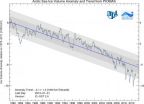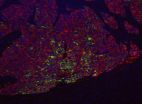(Press-News.org) The September 2012 record low in Arctic sea-ice extent was big news, but a missing piece of the puzzle was lurking below the ocean's surface. What volume of ice floats on Arctic waters? And how does that compare to previous summers? These are difficult but important questions, because how much ice actually remains suggests how vulnerable the ice pack will be to more warming.
New satellite observations confirm a University of Washington analysis that for the past three years has produced widely quoted estimates of Arctic sea-ice volume. Findings based on observations from a European Space Agency satellite, published online in Geophysical Research Letters, show that the Arctic has lost more than a third of summer sea-ice volume since a decade ago, when a U.S. satellite collected similar data.
Combining the UW model and the new satellite observations suggests the summer minimum in Arctic sea ice is one-fifth of what it was in 1980, when the model begins.
"Other people had argued that 75 to 80 percent ice volume loss was too aggressive," said co-author Axel Schweiger, a polar scientist in the UW Applied Physics Laboratory. "What this new paper shows is that our ice loss estimates may have been too conservative, and that the recent decline is possibly more rapid."
The system developed at the UW provides a 34-year monthly picture of what's happening to the total volume of Arctic sea ice. The Pan-Arctic Ice Ocean Modeling and Assimilation System, or PIOMAS, combines weather records, sea-surface temperature and satellite pictures of ice coverage to compute ice volume. It then verifies the results with actual thickness measurements from individual moorings or submarines that cruise below the ice.
"Because the ice is so variable, you don't get a full picture of it from any of those observations," Schweiger said. "So this model is the only way to reconstruct a time series that spans multiple decades."
The UW system also checks its results against five years of precise ice thickness measurements collected by a specialized satellite launched by NASA in 2003. The Ice, Cloud, and Land Elevation Satellite, or ICESat, measured ice thickness across the Arctic to within 37 centimeters (15 inches) until spring of 2008.
The U.K.'s CryoSat-2 satellite resumed complete ice thickness measurements in 2010; this is the first scientific paper to share its findings about the recent years of record-low sea ice.
Between 2008 and now, the widely cited UW figures have generated some controversy because of the substantial ice loss they showed.
"The reanalysis relies on a model, so some people have, justifiably, questioned it," Schweiger said. "These data essentially confirm that in the last few years, for which we haven't really had data, the observations are very close to what we see in the model. So that increases our confidence for the overall time series from 1979 to the present."
Arctic sea ice is shrinking and thinning at the same time, Schweiger explained, so it's normal for the summer ice volume to drop faster than the area covered, which today is about half of what it was in 1980.
Schweiger cautioned that past trends may not necessarily continue at the same rate, and predicting when the Arctic might be largely ice-free in summer is a different question. But creating a reliable record of the past helps to understand changes in the Arctic and ultimately helps to better predict the future.
"One question we now need to ask, and can ask, is what are the processes that are driving these changes in the ice? To what degree is it ocean processes, to what degree is this in the atmosphere?" Schweiger said. "I don't think we have a good handle on that yet."
The UW system was created by co-author Jinlun Zhang, an oceanographer at the Applied Physics Laboratory. The UW portion of the research was funded by NASA and the Office of Naval Research.
INFORMATION:
Other co-authors are first author Seymour Laxon, Katharine Giles, Andy Ridout, Duncan Wingham and Rosemary Willatt at University College London; Robert Cullen and Malcolm Davidson at the European Space Agency; Ron Kwok at NASA's Jet Propulsion Laboratory; Christian Haas at York University in Canada; Stefan Hendricks at the Alfred Wegener Institute for Polar and Marine Research in Germany; Richard Krishfield at Woods Hole Oceanographic Institution; and Nathan Kurtz at Morgan State University in Baltimore.
For more information, contact Schweiger at 206-543-1312 or axel@apl.washington.edu.
At the U.K.'s Natural Environment Research Council, contact pressoffice@nerc.ac.uk or Tamera Jones, +44 01793 411561.
European satellite confirms UW numbers: Arctic Ocean is on thin ice
2013-02-13
ELSE PRESS RELEASES FROM THIS DATE:
We're emotionally distant and that's just fine by me
2013-02-13
When it comes to having a lasting and fulfilling relationship, common wisdom says that feeling close to your romantic partner is paramount. But a new study finds that it's not how close you feel that matters most, it's whether you are as close as you want to be, even if that's really not close at all.
"Our study found that people who yearn for a more intimate partnership and people who crave more distance are equally at risk for having a problematic relationship," says the study's lead author, David M. Frost, PhD, of Columbia University's Mailman School of Public Health. ...
Video study shows which fish clean up coral reefs, showing importance of biodiversity
2013-02-13
Using underwater video cameras to record fish feeding on South Pacific coral reefs, scientists have found that herbivorous fish can be picky eaters – a trait that could spell trouble for endangered reef systems.
In a study done at the Fiji Islands, the researchers learned that just four species of herbivorous fish were primarily responsible for removing common and potentially harmful seaweeds on reefs – and that each type of seaweed is eaten by a different fish species. The research demonstrates that particular species, and certain mixes of species, are potentially critical ...
Penn vet team uncovers a pathway that stimulates bone growth
2013-02-13
PHILADELPHIA — Researchers from the University of Pennsylvania School of Veterinary Medicine have discovered that a protein called Jagged-1 stimulates human stem cells to differentiate into bone-producing cells. This protein could help both human and animal patients heal from bone fractures faster and may form the basis of treatments for a rare metabolic condition called Alagille syndrome.
The study, published in the journal Stem Cells, was authored by three members of Penn Vet's departments of Clinical Studies-New Bolton Center and Animal Biology: postdoctoral researchers ...
FASEB joins President Obama in urging Congress to sustain investments in research and innovation
2013-02-13
FASEB also praised the President's emphasis on increasing investments in science and innovation. President Obama said, "Now is not the time to gut these job-creating investments in science and innovation. Now is the time to reach a level of research and development not seen since the height of the Space Race." In addition, the President noted that the automatic spending cuts known as sequestration would devastate priorities like education, energy, and medical research. "We will continue our advocacy efforts to urge Congress to sustain federal funding for the National Institutes ...
Opera's poisons and potions connect students with chemistry
2013-02-13
Opera audiences can feel the chemistry in romance-inspired classics like Mimi's aria from La Bohème, Cavaradossi's remembrance of his beloved while awaiting execution in Tosca and that young lady pining for her man with "O mio babbino caro" in the opera Gianni Schicchi. An article in ACS' Journal of Chemical Education, however, focuses on the real chemistry — of poisons and potions — that intertwines famous operatic plots.
João Paulo André points out that opera, in addition to being a form of theater, can be used as a teaching tool for chemistry students and the general ...
Advance promises to expand biological control of crop pests
2013-02-13
A new discovery promises to allow expanded use of a mainstay biological pest control method, which avoids the health, environmental and pest-resistance concerns of traditional insecticides, scientists are reporting. The advance toward broadening applicability of the so-called sterile insect technique (SIT) appears in the journal ACS Synthetic Biology.
Luke Alphey and colleagues explain that the Lepidoptera, a large family of insects with a caterpillar stage, cause widespread damage worldwide to cotton; apples, pears and other fruits; and vegetable crops like broccoli, ...
Researchers discover biological diversity in triple-negative breast cancer
2013-02-13
CHAPEL HILL, N.C. – Triple-negative breast cancers are more biologically diverse than previously believed and classification should be expanded to reflect this heterogeneity, according to University of North Carolina researchers.
In a study published in the February issue of The Oncologist conducted by UNC and the Vall d'Hebron Institute of Oncology in Barcelona, Spain, a team lead by Charles Perou, PhD, of UNC Lineberger Comprehensive Cancer Center, examined more than 1,700 breast tumors, including 412 triple negative (TN) breast cancers, and concluded that triple-negative ...
Vitamin C is beneficial against the common cold
2013-02-13
Vitamin C seems to be particularly beneficial for people under heavy physical stress. In five randomized trials of participants with heavy short-term physical stress, vitamin C halved the incidence of the common cold.
Three of the trials studied marathon runners, one studied Swiss school children in a skiing camp and one studied Canadian soldiers during a winter exercise.
Furthermore, in a recent randomized trial carried out with adolescent competitive swimmers, vitamin C halved the duration of colds in males, although the vitamin had no effect on females.
Regular ...
Kinect teleport for remote medicine
2013-02-13
The Microsoft Kinect game controller could cut the US healthcare bill by up to $30 billion by allowing physicians and other medics to interact with patients remotely so reducing the number of hospital visits and the associated risk of infection.
Writing in the latest issue of the International Journal of Electronic Finance, Janet Bailey of the University of Arkansas at Little Rock is working with Bradley Jensen of Microsoft Corporation, in Irving, Texas, to explain how gaming technology could be used to "teleport" the knowledge and skills of healthcare workers to where ...
Additional noteworthy research to be presented at the 2013 Genitourinary Cancers Symposium
2013-02-13
ALEXANDRIA, Va. – Co-sponsors of the 2013 Genitourinary Cancers Symposium announced today important research to be presented at this year's meeting, taking place February 14-16 at the Rosen Shingle Creek in Orlando, Florida. Three of the featured studies focus on the prevention, diagnosis and treatment of prostate cancers; another study looks at a new immunotherapy for metastatic kidney cancer.
Thursday, February 14 Presentations
Abstract # 10: Long-term survival of subjects in the prostate cancer prevention trial.
General Poster Session A
Thursday, February 14, ...


